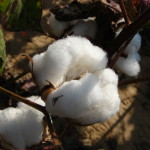 There is no question that defoliating cotton this year will be challenging. Many of these challenges can be attributed to late planting dates, too much moisture during the growing season, lack of DD60 accumulation, or from planting a later maturing variety. Regardless the cause, there are many questions and concerns coming in about harvest aid materials as we start moving closer to harvest season.
There is no question that defoliating cotton this year will be challenging. Many of these challenges can be attributed to late planting dates, too much moisture during the growing season, lack of DD60 accumulation, or from planting a later maturing variety. Regardless the cause, there are many questions and concerns coming in about harvest aid materials as we start moving closer to harvest season.
Last Thursday, 09/19/2013, we put out a defoliation strip trial here in Jackson, TN at the WTREC. A variety of harvest aid materials (see list below) are being evaluated in both a single pass and a double pass approach to evaluate which materials are working the best in current environmental conditions. This cotton variety used in this trial is PHY 375 WRF that was about 35-40% open at the time of the first application. The treatments receiving a second, follow-up application were sprayed today, 09/26/2013, and all applications were made at 10 GPA. Ethephon was added to all the treatments to enhance boll opening or as part of a two-pass system. I have put up treatment signs on this trial, so feel free to come visit us at WTREC and see this defoliation demo. (Plot Coordinates: N35.621530, W088.843350)
Overall, all the treatments are doing what we would typically expect with current environmental conditions. We have accumulated approximately 75 DD60’s since the first application and had fairly good weather conditions. Therefore, the phosphate-type materials (Def, Folex, etc.) and the thidiazuron products (Daze, Dropp, FreeFall, Ginstar, etc.) are the strongest performers. However, as the weather starts to cool off, minimum temperatures less than 60 degrees F, we will need to start focusing on other products that work better in cooler situations such as Aim and ET. Also, if you find yourself battling a thick, rank canopy a stout shot of Finish (21-32 oz/a) is working well in our trial. It typically opens the bolls a little quicker and drops a few more leaves than generic ethephon
As we move forward the key is going to be choosing the correct product for the job, being mindful of your environment, and to have realistic expectations. We have already discussed some of the products, so I will just remind you that it is always a good practice to check the weather forecast for at least the first 3-5 days after the intended application of harvest aid materials to ensure a cold snap is not going to set in. This weather forecast can be very helpful in choosing products and rates. Lastly, just be realistic in your expectations. Know that a two-pass program is probably going to be needed if you have a late maturing variety that has a thick, vegetative canopy.
|
Treatment No. |
First Application (09/19/2013) |
Second Application (09/26/2013) |
|
1 |
Def (4 oz/a) + Prep (24 oz/a) |
None |
|
2 |
Daze (2 oz/a) + Prep (24 oz/a) |
None |
|
3 |
Aim (0.5 oz/a) + Prep (24 oz/a) |
None |
|
4 |
ET (1.5 oz/a) + Prep ( 24 oz/a) + COC (1% v/v) |
None |
|
5 |
Ginstar (1 oz/a) + Def (3 oz/a) + Prep (24 oz/a) |
None |
|
6 |
Def (2 oz/a) + Daze (2 oz/a) + Prep (24 oz/a) |
None |
|
7 |
Def (3 oz/a) + Prep (32 oz/a) |
None |
|
8 |
Def (3 oz/a) + Finish (21 oz/a) |
None |
|
9 |
Prep (32 oz/a) |
Def (3 oz/a) + Finish (21 oz/a) |
|
10 |
Prep (32 oz/a) |
Aim (0.75 oz/a) + Finish (21 oz/a) |
|
11 |
Prep (32 oz/a) |
Ginstar (12 oz/a) + Finish (21 oz/a) |
|
12 |
Prep (32 oz/a) |
ET (1.5 oz/a) + Finish (21 oz/a) + COC (1% v/v) |
|
13 |
Daze (2 oz/a) + Prep (16 oz/a) |
Def (3 oz/a) + Finish (21 oz/a) |
|
14 |
Prep (32 oz/a) |
Daze (6 oz/a) + Aim (0.75 oz/a) |
|
15 |
Prep (32 oz/a) |
Def (10 oz/a) + Finish (21 oz/a) |
|
16 |
Daze (2 oz/a) + Prep (24 oz/a) |
Finish (21 oz/a) |


